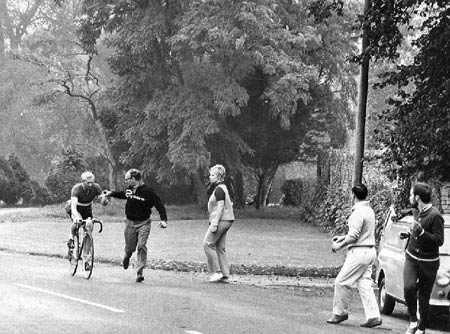A float day is when all the planets align and the weather gods smile down on the time triallist, with perfect conditions. No wind and warm. Fast to the turn, fast on the way back. With the same power output, your times are 2-3 minutes quicker, and after the race, you see many people looking at the result board with big grins.

The last time, we had a proper float day seems in the days when Fred Perry was still winning at Wimbledon. I certainly can’t remember a float day this year. The best day was probably doing the Buxton Mt TT, but it wasn’t exactly a course for getting 30 mph average speeds.
The good thing about time trials is that you don’t to have a float day. You’re always racing against yourself, you’re racing against your competitors. What is important is the chance to test yourself against riders of similar abilities -the chance to compete against yourself. Since it always seems to be windy anyway, you can compare your times week to week.
But, although, time trials is much more than getting a pb, any timetriallist is lying if they say they don’t look forward to float days. This weekend was that rare combination of circumstances – hot weather, dry, low wind.
It’s always a good sign when you get to a cycle race and you see a collection of hot air balloons floating over the course. Hot air balloons generally mean one thing, low wind and balmy conditions.
This was my third 50 of the season. Usually, I only do one or two, so I’m getting a bit more used to riding them. Despite racing the previous day (13 mile TT Clifton CC) I was reasonably fresh and looking forward to the race. This event was the Yorkshire Cycling Federation 50. Held for the past 82 years, since its inauguration in 1926.
To say it was a ‘float’ day, it was actually quite hard work up the hill into a light headwind. The wind barely moved the trees, but it took the edge off the speed and I reached the turn with a disappointing average of 26.9mph. Coming off the A19, there was a long turn, with a very heavy road surface. It felt like riding on treacle compared to the smooth dual carriageway. Back on the A19 and the return leg felt super-fast. Often in 50 mile Time trials, I start off at a good pace, but suffer on the last 10 miles, watching your average slowly fall away. Certainly this was the case in the National 50 where the last 10 miles was into that stiff Welsh headwind. But, the last 10 miles in this 50 took a rather incongruous 18.49 – (it would have been a pb for 10 miles.) It was a super fast finish, and I was able to set a new pb of 1.45.56 (average 28.5mph). It was 3 and half minutes quicker than previous best set in 2011.
The only downside of float days is that you can feel flattered by the high speeds. I probably had a higher power average for the last 10 miles in the Welsh 50 doing 20mph, then I did in this race averaging 32 mph. Anyway it was good to finish before the day got really hot. I could then spend the next few hours ‘recovering’ on the conch watching another fascinating tour de France stage.
The race was well organised by the Yorkshire Cycling Federation (Course: V259). It was good to be taking part in a race with an 82 year history. It makes it feel quite special. I finished 2nd behind Andy Jackson of Team Swift who did 1.44.11
The Andy Wilson Memorial
Andy Wilson, son of the late John Wilson (ex secretary of the Yorkshire Cycling Federation) was an outstanding rider of the 1920s. A one time member of the Yorkshire RC, Hull Thursday RC and the Clifton CC, he excelled at all distances up to 100 miles, and in the three years prior to his death was defeated only once in a time trial in Britain. A BSc, he worked as a chemist at Terry’s York, and had lodgings at Ebor Street. He was sturdily built; having the ability to ride at a consistently high speed in any conditions, but at all times was a modest person. He never rode a “12″ on the 2nd April (Good Friday) 1926, he broke the York-Edinburgh record by a handsome margin. In Mid-April of the same year, he caught a chill, complications set in, and he died on the 21st April – the same day Queen Elizabeth II was born. He was then 23 years of age.
The Funeral was one of the largest Leeds had ever seen, and the many cyclists present, walked with their cycles, in front of the Hearse, from his parents home at Grange Avenue, the one mile to Harehills Cemetery, where is grave is still in good condition.
The memorial was inaugurated shortly afterwards, being subscribed by clubs and individuals from all over the country. Trustees were appointed and a unique Memorial Trophy, bearing a facsimile figure in silver, of Andy Wilson on his machine, was purchased. The first “memorial “50″ took place in August 1936, and has been held annually (with exception of 1940-45 war years) ever since. Many famous names have been engraved on the memorial over the years.
The current organiser is only the 5th in the long history of the event. From 1926-1955, one of Yorkshire’s greatest cycling administrators, Charles Arthur Rhodes, a Trustee of the Wilson Memorial until his death in 1961, was its organiser. A remarkable achievement by a remarkable gentleman. Eddie Longthorpe followed, organising until 1978, except 1966, 1967 and 1972 when Peter Greenwood was in charge, and in 1977, when Bryan Peel promoted the event for the first time, and then took over from 1979 until retiring after the 2009 event.

No comments yet.